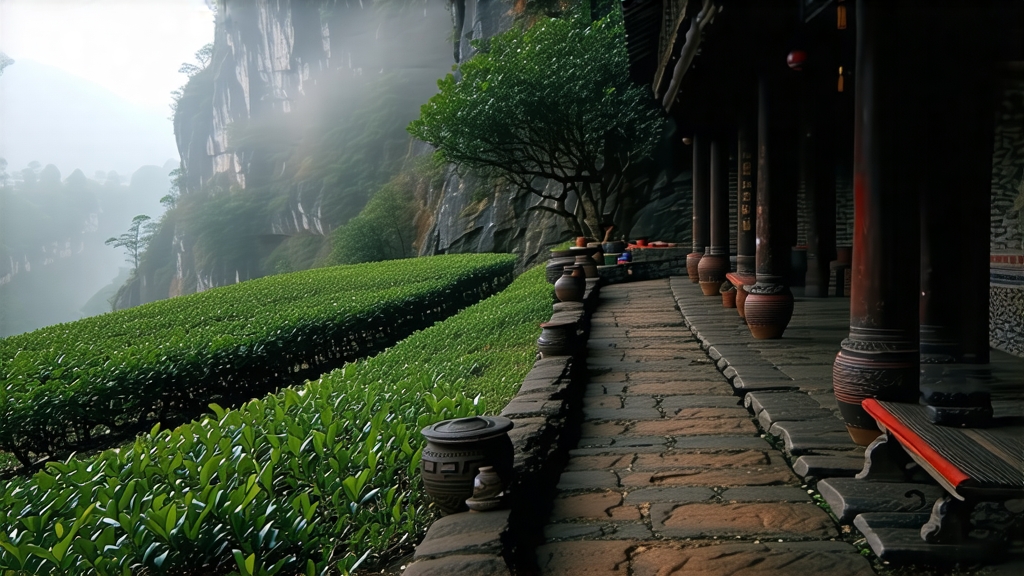
If green tea is the dewy youth of Chinese tea and pu-erh its venerable sage, then Wuyi Da Hong Pao stands somewhere between—an oolong of imperial swagger and monastic poise, born on sheer cliffs where mist and myth intertwine. Literally “Big Red Robe,” this legendary yancha (rock tea) carries the mineral soul of its terroir and the incense of centuries-old charcoal craft. To international drinkers who equate “oolong” only with the rolled green pellets of Tie Guan Yin, Da Hong Pao offers a darker, more orchestral experience: cacao, orchid, burnt caramel and the unmistakable “yan yun” (rock rhyme) that lingers like a struck bell.
Historical scrolls and local lore agree that the original mother trees—six ancient bushes still clinging to a tiny fissure on Tianxin Rock—were first honored in the Ming dynasty. The most repeated tale tells of a Ming scholar who, cured by the tea en route to the capital, draped his crimson imperial robe over the bushes in gratitude. Whether apocryphal or not, the name stuck, and so did the prestige: Qing emperors listed it among their gongcha (tribute teas), while 1972 Nixon’s landmark visit saw Mao Zedong gift 50 grams of mother-tree leaf—an amount then worth more than its weight in gold. Today the mother trees are officially retired from plucking, protected by cameras and armed guards, yet the genetic lineage lives on through asexually propagated clones (queen or “qi dan”) and skillful blending of compatible Wuyi cultivars (collectively called “commodity Da Hong Pao”).
Botanically, the Wuyi garden is a living museum of cliff-adapted bushes: Bei Dou #1, a direct clone of the mother tree; Qi Dan, prized for its lilac nose; and the older workhorses such as Rou Gui (cassia) and Shui Xian (narcissus) that often find their way into commercial blends. Each cultivar is trained on narrow ledges called “wudeng” (terraces of rock) where daytime heat radiates from stone and night temperatures plummet, forcing the leaves to thicken and hoard aromatic oils. The soil is almost pure volcanic tuff, so porous that rainwater disappears within seconds, obliging the roots to dive three meters or more for groundwater, sipping on a mineral broth that gives yancha its ferric, flinty signature.
Crafting Da Hong Pao is a two-week odyssey that begins under starlight. Pickers start at 2 a.m. when the dew is heavy and oxidation enzymes are sluggish; only the middle three leaves are snapped, using a twist-and-lift motion that avoids the woody stem. By dawn the sacks arrive at the cottage factory where the green leaf is “withered” on bamboo racks in direct mountain wind, a phase called “wei diao” that can last four hours and determines 70 % of the final cup. Once the edges turn parchment-brown, the leaf is shaken in rattan drums every 20 minutes to bruise the margins while keeping the center intact—an art known as “yao qing” that coaxes partial oxidation to exactly 30–40 %. The rhythm is almost musical: shake, rest, sniff; shake, rest, sniff, until the room fills with peach-skin and copper-penny aromas.
Firing follows, first in electric tumblers at 220 °C for eight minutes to arrest oxidation, then the signature charcoal roasting that separates Wuyi masters from the rest. Using only local hardwoods (mostly longan and lychee), the tea is baked above ash-covered embers for 6–12 hours, left to rest for a week, then baked again—up to three cycles. Between each roast the baker sleeps on a bamboo cot beside the pit, waking every 30 minutes to adjust the depth of ash; one extra centimeter can scorch the leaf or leave it damp and “green-hearted.” The finished maocha is sorted by eye, stripped of stems and yellow leaves, then given a final “foot fire” so gentle that the charcoal is almost out, coaxing the famous “longan-burnt honey” note without smoke.
To brew Da Hong Pao like a Wuyi local you need only a 100 ml gaiwan, 5 g of leaf and water just off a rolling boil. Pre-heat